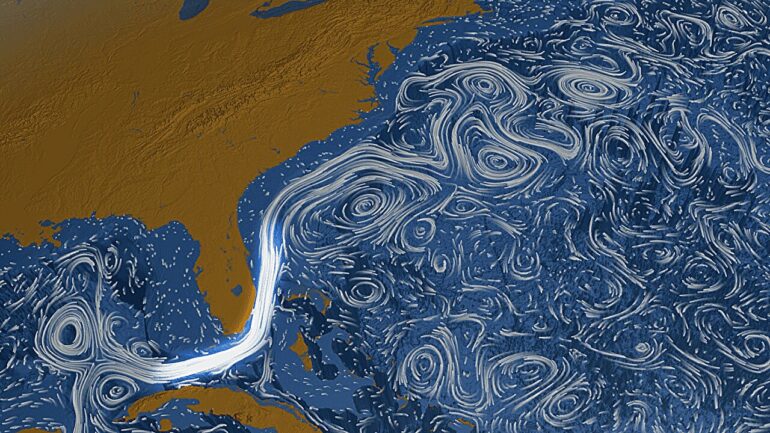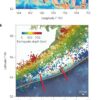There is growing scientific interest in quantifying how large-scale ocean circulation is evolving as part of a changing global climate. Of particular interest is the potential weakening of the Atlantic Meridional Overturning Circulation (AMOC).
However, the strength of the Florida Current, a key component of the AMOC, has remained stable for the past four decades, according to a new study published in Nature Communications by scientists at NOAA’s Atlantic Oceanographic and Meteorological Laboratory (AOML), the University of Miami Cooperative Institute for Marine and Atmospheric Studies (CIMAS) and Rosenstiel School, and the National Oceanography Center (U.K.).
The AMOC is the Atlantic (Ocean) portion of the Global Meridional Overturning Circulation (MOC). It is an important part of this global system that moves water northwards and southwards in the Atlantic Ocean, connecting surface and bottom water flows across the globe.
The AMOC controls the transport of heat, freshwater, carbon, nutrients, and other properties across the basin, meaning that changes in the AMOC’s strength could impact many global scale climate phenomena such as sea level, extreme weather, and precipitation patterns.
Current state-of-the-art climate models, including the NOAA model, suggest a decline of the AMOC by up to 45% of its present-day strength toward the end of this century. The latest Intergovernmental Panel on Climate Change report is based on these models. However, there is no clear observational evidence to support a significant slowdown of the AMOC in recent decades.
In this study, scientists have found through observations that the Florida Current, one of the fastest currents in the ocean and an important part of the AMOC, has remained remarkably stable over the past 40 years.
The Florida Current is a strong ocean current that originates in the Gulf of Mexico and flows along the east coast of Florida through the Florida Straits, into the open North Atlantic Ocean, where the flow becomes the Gulf Stream.
Scientists monitor the Florida Current because of its influence on societal issues, including changes in coastal sea level and flooding events, as well as its role in weather and climate patterns. The current carries heat and salt northward in the subtropical North Atlantic and is a major contributor to the AMOC.
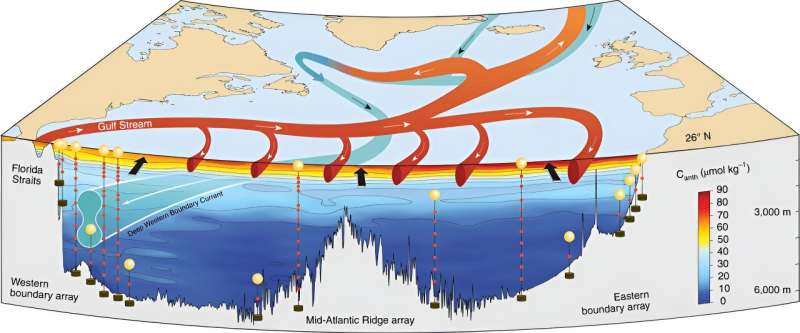
Schematic of the RAPID/MOCHA/WBTS Array in relation to meridional overturning circulation pattern. © University of Miami
Since 1982, NOAA’s Western Boundary Time Series (WBTS) project and its predecessors have monitored the transport of the Florida Current between Florida and the Bahamas at 27°N using a 120-km long submarine cable paired with regular hydrographic cruises in the Florida Straits. This nearly continuous monitoring has provided the longest observational record of a boundary current in existence.
Beginning in 2004, NOAA’s WBTS project partnered with the United Kingdom’s Rapid Climate Change program (RAPID) and the University of Miami’s Meridional Overturning Circulation and Heatflux Array (MOCHA) programs to establish the first transbasin AMOC observing array at about 26.5N.
Through the WBTS project, the strength of the Florida Current has been inferred from voltages measured on a decommissioned submarine telephone cable spanning the seafloor between Florida and the Bahamas. Due to the Earth’s magnetic field, as salt ions in the seawater are transported by the Florida Current over the cable, a measurable voltage is transmitted to the cable.
Using regular ship-based measurements, this voltage record can be correlated to the volume transport of the Florida Current. The resulting cable measurement time series has provided a daily transport record of the Florida Current for more than 40 years.
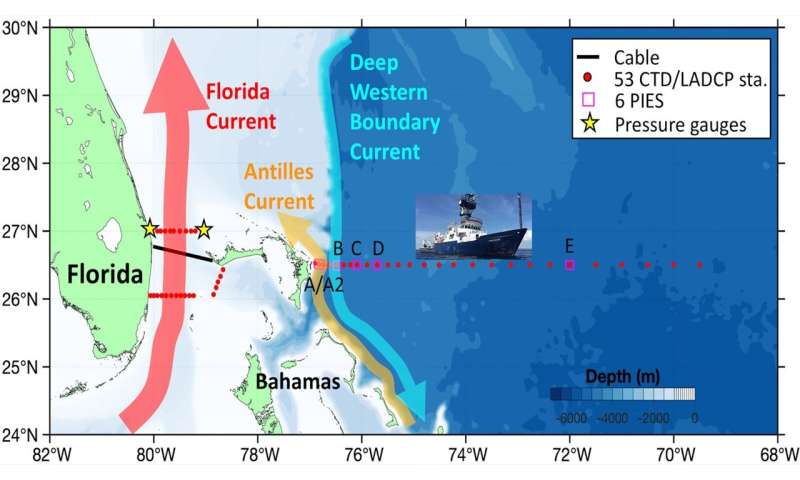
WBTS hydrographic measurement sites (red dots) and mooring locations are shown above. WBTS moorings include Pressure Inverted Echosounders (PIES) along the 26.5°N section (magenta squares) and shallow pressure gauges on either side of the Florida Straits (yellow stars). The Florida Current Cable (black line) and western boundary currents are also shown. MOCHA and RAPID measurement sites (not shown) are also located along the 26.5°N section, east of the Bahamas, extending eastward across the North Atlantic Ocean (see first figure). © NOAA Headquarters
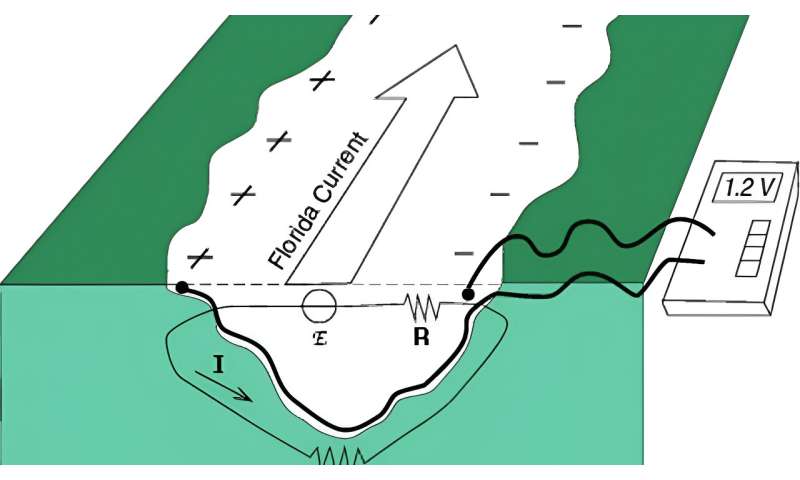
Schematic of the WBTS cable voltage monitoring system in the Florida Straits. © NOAA Headquarters
In this new study, WBTS scientists reassessed the overall trend in the Florida Current transport inferred from the cable measurements. They found that voltages measured on the cable beginning in 2000 required a correction for the gradual change in the Earth’s magnetic field over time. The correction nearly removed a previously reported negative trend in the record, revealing that the Florida Current has remained stable for the past four decades.
This result contradicts previous claims made regarding a statistically significant decline of the Florida Current at 27°N, and subsequently reduces the negative trend (i.e., the weakening) previously observed in the AMOC time series at 26.5°N. Several previous studies that showed a slowing of the Florida Current were based on data from the cable prior to the correction.
“The use of the corrected Florida Current transport time series reduces the negative trend in the AMOC from 2004 to 2022 by about 40% and makes it only marginally significant in a statistical sense,” said Denis Volkov, Ph.D., CIMAS scientist and lead author of the study.
If climate models are correct and the AMOC is slowing or will slow down, this study indicates that such a slowdown has not yet been reflected in the Florida Current, or that the observational records are still too short to detect it with confidence.
Nevertheless, the importance of both the Florida Current and the AMOC in regional and global climate variability demonstrates the value of sustained observations at 26.5°N. The existing records are just starting to reveal decadal-scale signals relevant to climate variability.
“Although the AMOC observing system at 26.5N has 20 years of observations, the time series is still too short to draw definitive conclusions. Our study focuses on the long-term change in the Florida Current strength, which is an important component of the AMOC.
“However, it is possible that the AMOC is changing without a corresponding change in the Florida Current. The AMOC may still be weakening and/or what we are observing is just part of the interdecadal variability—we still need to find out,” said Volkov.
The corrected Florida Current transport time series is made freely available through the WBTS project’s webpage.
More information:
Denis L. Volkov et al, Florida Current transport observations reveal four decades of steady state, Nature Communications (2024). DOI: 10.1038/s41467-024-51879-5
Citation:
Reassessing the stability of the Florida Current: New insights from 40 years of observations (2024, September 11)
